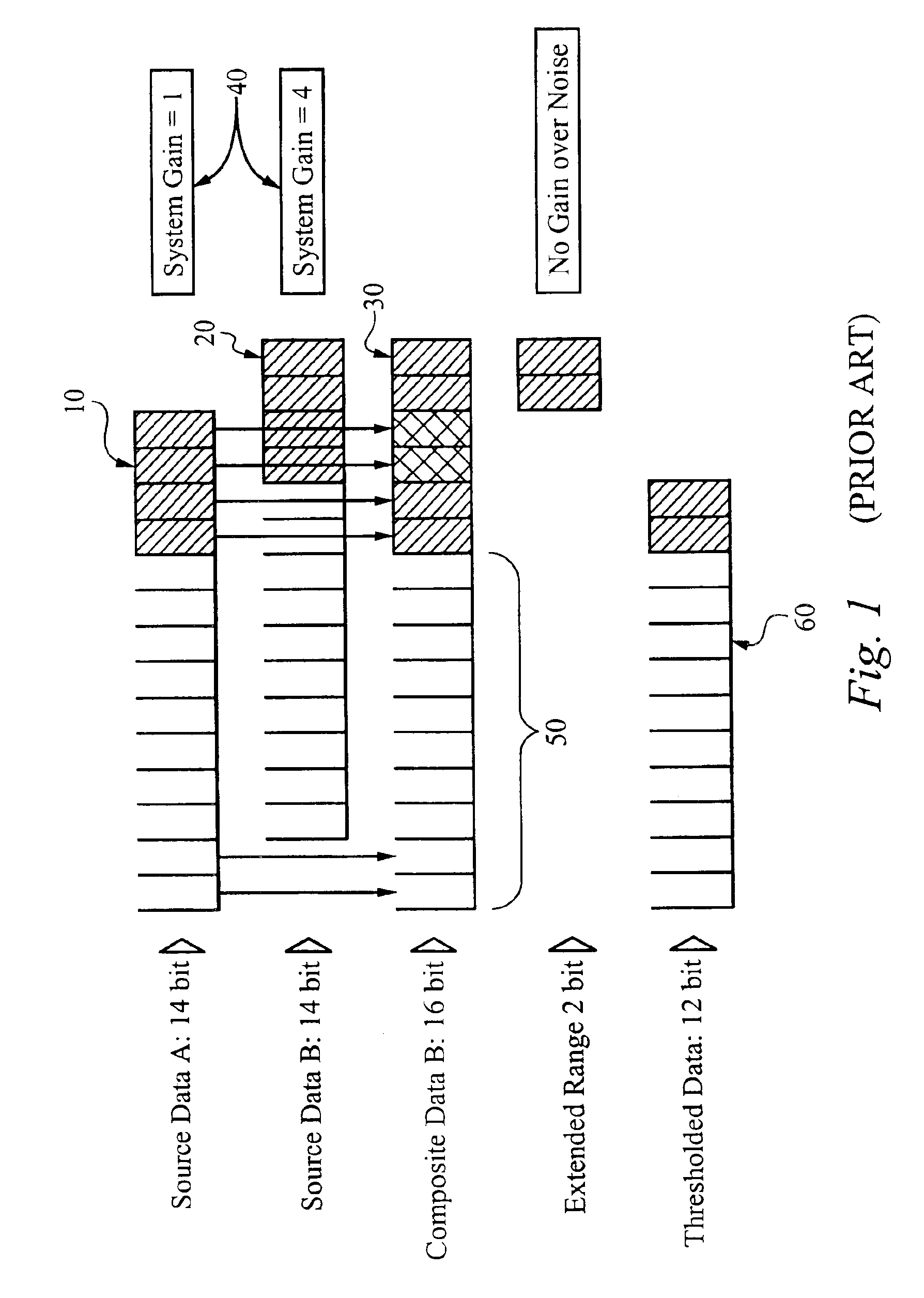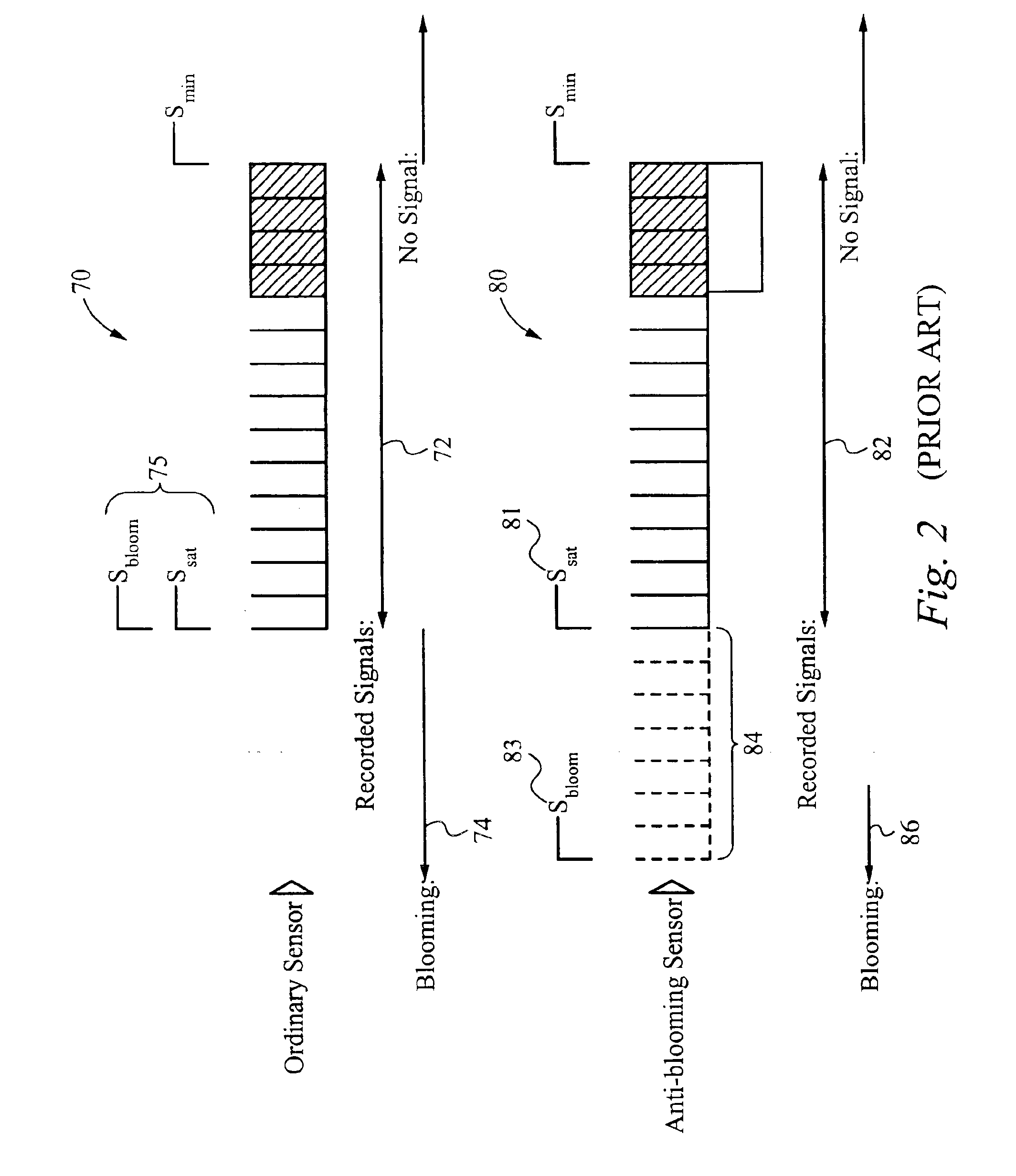[0016]In one aspect of the present invention, a method of extending a signal range of a
digital image comprises duplicating the
digital image such that a plurality of source images are formed, each of the source images including a predetermined number of the duplicated digital images, scaling each of the plurality of source images, wherein the scaling is based upon a
gain value assigned to each of the plurality of source images, reducing a
noise component in each of the plurality of source images, such that a plurality of noise reduced images are formed corresponding to each of the plurality of source images and adding the plurality of noise reduced images. The method further comprises receiving the digital image in a sensor and sending the digital image to a computer and outputting the sum of the plurality of noise reduced images to an
output device.
[0019]In the apparatus of this aspect, each of the plurality of noise reduced images includes a single noise reduced image. The
gain value for each of the plurality of source images is 2x, such that the highest
gain value will not exceed 2x where x is an integer less than or equal to 10, and each successive gain value Will have a value of 2x−1. The predetermined number of duplicated digital images in each of the plurality of sources images is determined by 2x, wherein x is equal to 0 for the
source image having the highest gain value, and each successive
source image will have a number of duplicate digital images according to 2x+1. A user can set the highest gain value and the number of the plurality of source images. The reducing means reduces the
noise component in each of the plurality of source images, the computer averages each of the plurality of source images.
[0021]The computer includes means for duplicating the digital image such that a plurality of source images are formed, each of the source images including a predetermined number of the duplicated digital images, means for scaling each of the plurality of source images, wherein the scaling means are based upon a gain value assigned to each of the plurality of source images, means for reducing a
noise component in each of the plurality of source images, such that a plurality of noise reduced images are formed corresponding to each of the plurality of source images and means for adding the plurality of noise reduced images.
[0022]The apparatus also comprises means for receiving the digital image in a sensor and means for sending the digital image to a computer and means for outputting the sum of the plurality of noise reduced images to an
output device. Also, each of the plurality of noise reduced images includes a single noise reduced image. The gain value for each of the plurality of source images is 2x, such that the highest gain value will not exceed 2x where x is an integer less than or equal to 10, and each successive gain value will have a value of 2x−1. The predetermined number of duplicated digital images in each of the plurality of sources images is determined by 2x, wherein x is equal to 0 for the
source image having the highest gain value, and each successive source image will have a number of duplicate digital images according to 2x+1. A user can set the highest gain value and the number of the plurality of source images. When the reducing means reduces the noise component in each of the plurality of source images, the computer averages each of the plurality of source images. The sensor is a
charge coupled device or a complementary
metal oxide semiconductor. The
output device is a video monitor or a printer.
[0024]In the article of manufacture of this aspect, each of the plurality of noise reduced images includes a single noise reduced image. The gain value for each of the plurality of source images is 2x, such that the highest gain value will not exceed 2x where x is an integer less than or equal to 10, and each successive gain value will have a value of 2x−1. The predetermined number of duplicated digital images in each of the plurality of sources images is determined by 2x, wherein x is equal to 0 for the source image having the highest gain value, and each successive source image will have a number of duplicate digital images according to 2x+1. A user can set the highest gain value and the number of the plurality of source images. When the reducing means reduces the noise component in each of the plurality of source images, the computer averages each of the plurality of source images.
[0025]In yet another aspect of the present invention, an apparatus for extending a signal range of a digital image comprises a storage media for storing a computer application, a
processing unit coupled to the storage media and a
user interface coupled to the
processing unit such that a user can duplicate the digital image to form a plurality of source images, scale each of the plurality of source images, reduce a noise component in each of the plurality of source images and add the plurality of source images.
 Login to View More
Login to View More  Login to View More
Login to View More 


